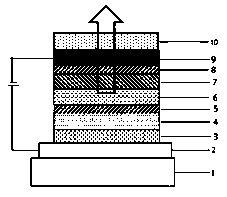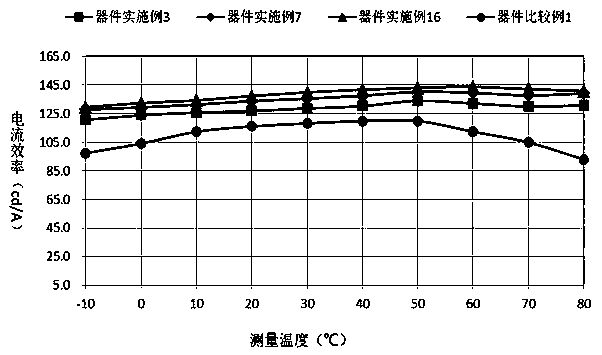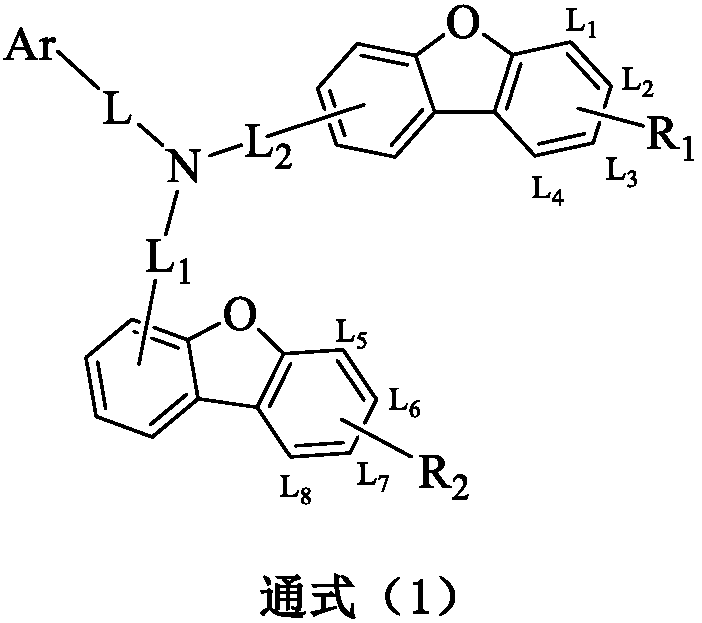Organic compound taking triarylamine as core, and preparation method and application thereof
A technology for organic compounds and triarylamines, applied in the field of organic compounds and their preparation, can solve problems such as differences, and achieve the effects of high glass transition temperature, good film-forming properties and thermal stability, and not easy to crystallize
- Summary
- Abstract
- Description
- Claims
- Application Information
AI Technical Summary
Problems solved by technology
Method used
Image
Examples
Embodiment 1
[0066] Embodiment 1: the synthesis of intermediate B1:
[0067]
[0068] In a 250ml three-neck flask, under the protection of nitrogen, add 0.01mol raw material 1-1, 0.012mol raw material 2-1, 150ml toluene and stir to mix, then add 5×10-5molPd 2 (dba) 3 , 5×10 -5 mol P(t-Bu) 3 , 0.03mol sodium tert-butoxide, heated to 105°C, refluxed for 24 hours, sampling plate, showed no bromide remaining, the reaction was complete; naturally cooled to room temperature, filtered, the filtrate was rotary evaporated to no fraction, passed through a neutral silica gel column , obtain target product intermediate B1; HPLC purity 99.43%, yield 71.3%; Elemental analysis structure (molecular formula C 36 h 19 NO 4 ): Theoretical value: C, 81.65; H, 3.62; N, 2.65; O, 12.08; Test value: C, 81.63; H, 3.61; N, 2.66; ESI-MS (m / z) (M+): The theoretical value is 529.55, and the measured value is 529.58.
[0069] The synthesis of intermediate B required in the examples refers to the synthesis of ...
Embodiment 2
[0074] Embodiment 2: the synthesis of compound 1:
[0075]
[0076] In a 250ml three-neck flask, under the protection of nitrogen, add 0.01mol intermediate B1, 0.012mol raw material C1, 150ml toluene and stir to mix, then add 5×10 -5 molPd 2 (dba) 3 , 5×10 -5 mol P(t-Bu) 3 , 0.03mol sodium tert-butoxide, heated to 105°C, refluxed for 24 hours, sampling plate, showed no bromide remaining, the reaction was complete; naturally cooled to room temperature, filtered, the filtrate was rotary evaporated to no fraction, passed through a neutral silica gel column , the target product was obtained, the HPLC purity was 99.54%, and the yield was 73.4%. Elemental analysis structure (molecular formula C 48 h 27 NO 4 ): theoretical value: C, 84.57; H, 3.99; N, 2.05; 0, 9.39; test value C, 84.56; HPLC-MS: The molecular weight of the material is 681.19, and the measured molecular weight is 681.32.
Embodiment 3
[0077] Embodiment 3: the synthesis of compound 7:
[0078]
[0079] Prepare by the synthetic method of compound 1 in embodiment 2, difference is to replace intermediate B1 with intermediate B2; Elemental analysis structure (molecular formula C 48 h 27 NO 4 ): theoretical value: C, 84.57; H, 3.99; N, 2.05; 0, 9.39; test value C, 84.56; HPLC-MS: The molecular weight of the material is 681.19, and the measured molecular weight is 681.32.
PUM
| Property | Measurement | Unit |
|---|---|---|
| Thickness | aaaaa | aaaaa |
| Thickness | aaaaa | aaaaa |
| Thickness | aaaaa | aaaaa |
Abstract
Description
Claims
Application Information
 Login to View More
Login to View More - R&D
- Intellectual Property
- Life Sciences
- Materials
- Tech Scout
- Unparalleled Data Quality
- Higher Quality Content
- 60% Fewer Hallucinations
Browse by: Latest US Patents, China's latest patents, Technical Efficacy Thesaurus, Application Domain, Technology Topic, Popular Technical Reports.
© 2025 PatSnap. All rights reserved.Legal|Privacy policy|Modern Slavery Act Transparency Statement|Sitemap|About US| Contact US: help@patsnap.com



